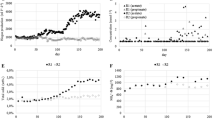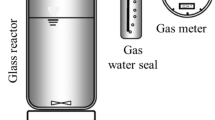Abstract
The effects of mesophilic anaerobic co-digestion (AcoD) of organic fraction of municipal solid waste (OFMSW) and sewage sludge (SS) on enhancement of biogas production were investigated under different types of sludge combinations (primary sludge PS, waste-activated sludge WAS and mixed sludge MS), varying mixing ratios of OFMSW and MS (50:50, 70:30, 80:20, 90:10, v/v) and varying total solid TS concentrations (6, 9, 12, 15%). The co-digestion of OFMSW with MS resulted in the biogas yield of 138 mL/gVS over mono-digestion of OFMSW (39 mL/gVS). Co-digestion of OFMSW + PS and OFMSW + WAS yielded biogas of 107 and 129 mL/gVS, respectively, which is less than that of OFMSW + MS (138 mL/gVS), respectively. The co-digestion of OFMSW with MS showed a 2.5 times increase in biogas yield over OFMSW digestion alone and 23% and 7% higher biogas yield than OFMSW + PS and OFMSW + WAS, respectively. The highest biogas yield of 967 mL/g VS was observed at TS concentration of 9% and OFMSW to the MS mixing ratio of 80:20, respectively. The biogas yields at different TS percentages were modelled using Gompertz and Logistic models and fitted well.

Graphical abstract






Similar content being viewed by others
Data availability
The data and material on optimisation of anaerobic co-digestion was determined experimentally.
Abbreviations
- OFMSW:
-
Organic fraction of municipal solid waste
- PS:
-
Primary sludge
- WAS:
-
Waste-activated sludge
- MS:
-
Mixed sludge
- SS:
-
Sewage sludge
- AcoD:
-
Anaerobic co-digestion
- TS:
-
Total solid
- VS:
-
Volatile solid
- TKN:
-
Total Kjeldahl Nitrogen
- VFAs:
-
Volatile fatty acid
- VAP:
-
Value-added products
- RDF:
-
Refuse-derived fuel
- AD:
-
Anaerobic digestion
- GHG:
-
Greenhouse gas
- COD:
-
Chemical oxygen demand
- TOC:
-
Total organic carbon
- TAN:
-
Total ammonia nitrogen
- FW:
-
Food waste
- C/N:
-
Carbon to Nitrogen ratio
- F/M:
-
Food to microorganisms ratio
- WWTP:
-
Wastewater treatment plant
- CAPEX:
-
Capital expenditures
- OPEX:
-
Operational expenditure costs
- GM:
-
Gompertz Model
- LM:
-
Logistic Model
References
Zhang C, Su H, Baeyens J, Tan T (2014) Reviewing the anaerobic digestion of food waste for biogas production. Renew Sust Energ Rev 38:383–392
Sharholy M, Ahmad K, Mahmood G, Trivedi RC (2008) Municipal solid waste management system in India: a review. Waste Manag J 28:459–467
Waste to Energy Research Council (2012) Sustainable solid waste management in India. Earth Engineering Centre, Colombia
Rollefson J (2005) Anaerobic digestion of municipal solid waste its role in achieving waste diversion and Kyoto targets for Canada. Solid Waste And Recycling Journal, Canada
Kayhanian M, Hardy S (1994) The impact of four design parameters on the performance of a high-solids anaerobic digestion of municipal solid waste for fuel gas production. Environ Technol 15(6):557–567
Tyagi VK, Fdez-Güelfo LA, Zhou Y, Álvarez-Gallego CJ, Garcia LR, Ng WJ (2018) Anaerobic co-digestion of organic fraction of municipal solid waste (OFMSW): progress and challenges. Renew Sust Energ Rev 93:380–399
Jingura RM, Kamusoko R (2017) Methods for determination of biomethane potential of feedstocks: a review. Biofuel Res J 4(2):573–586
Zhu B, Gikas P, Zhang R, Lord J, Jenkins B, Li X (2009) Characteristics and biogas production potential of municipal solid wastes pretreated with a rotary drum reactor. Bioresour Technol 100(3):1122–1129
APHA (2005) Standards methods for the examination of water and wastewater, 20th edn. American Public Health Association, Washington
Gallego CJA (2005) Testing different procedures for the start up of a dry anaerobic co-digestion process of OFMSW and sewage sludge at thermophilic range (Doctoral dissertation, Universidad de Cadiz (Spain))
Sikora FJ, Moore KP (2014) Chapter 5. Soil test methods from the South-Eastern United States, southern extension and research activity information exchange group – 6
Hach-Lange (2010) Water analysis handbook, 5th edn. HACH Company, USA
DiLallo R, Albertson OE (1961) Volatile acids by direct titration. J Water Poll Control Fed:356–365
Li Y, Park SY, Zhu J (2011) Solid-state anaerobic digestion for methane production from organic waste. Renew Sust Energ Rev 15(1):821–826
Almomani F, Shawaqfah M, Bhosale RR, Kumar A, Khraisheh MAM (2017) Intermediate ozonation to enhance biogas production in batch and continuous systems using animal dung and agricultural waste. Int Biodeter Biodegrad 119:176–187
Fitamo T, Boldrin A, Boe K, Angelidaki I, Scheutz C (2016) Co-digestion of food and garden waste with mixed sludge from wastewater treatment in continuously stirred tank reactors. Bioresour Technol 206:245–254
Tang YQ, Shigemetsu T, Morimura S et al (2005) Microbial community analysis of mesophilic anaerobic protein degradation process using bovine serum albumin (BSA)-fed continuous cultivation. J Biosci Bioeng 99:150–164
Iacovidou E, Ohandja DG, Voulvoulis N (2012) Food waste co-digestion with sewage sludge–realising its potential in the UK. J Environ Manag 112:267–274
Demirekler E, Anderson GK (1998) Effect of sewage sludge addition on the start-up of the anaerobic digestion of OFMSW. Environ Technol 19(8):837–843
Almomani F, Bhosale R (2020) Enhancing the production of biogas through anaerobic co-digestion of agricultural waste and chemical pre-treatments. Chemosphere 126805
Nayono SE (2010) Anaerobic digestion of organic solid waste for energy production (Vol. 46). KIT Scientific Publishing
Sosnowski P, Klepacz-Smolka A, Kaczorek K, Ledakowicz S (2008) Kinetic investigations of methane co-fermentation of sewage sludge and organic fraction of municipal solid wastes. Bioresour Technol 99(13):5731–5737
Benbelkacem H, Bollon J, Bayard R, Escudie R, Buffiere P (2015) Towards optimization of the total solid content in high-solid (dry) municipal solid waste digestion. Chem Eng J 273:261–267
Karthikeyan OP, Visvanathan C (2013) Bio-energy recovery from high-solid organic substrates by dry anaerobic bio-conversion processes: a review. Rev Environ Sci Biotechnol 12:257–284
An D, Wang T, Zhou Q, Wang C, Yang Q, Xu B, Zhang Q (2017) Effects of total solids content on performance of sludge mesophilic anaerobic digestion and dewaterability of digested sludge. Waste Manag 62:188–193
Brown D, Shi J, Li Y (2012) Comparison of solid-state to liquid anaerobic digestion of lignocellulosic feedstocks for biogas production. Bioresour Technol 124:379–386
Dai X, Duan N, Dong B, Dai L (2013) High-solids anaerobic co-digestion of sewage sludge and food waste in comparison with mono digestions: stability and performance. Waste Manag 33:308–316
Heo NH, Park SC, Lee JS, Kang H, Park DH (2003) Single-stage anaerobic codigestion for mixture wastes of simulated Korean food waste and waste activated sludge. Appl Biochem Biotech 105–108:567–579
Ahmadi-Pirlou M, Ebrahimi-Nik M, Khojastehpour M, Ebrahimi SH (2017) Mesophilic co-digestion of municipal solid waste and sewage sludge: effect of mixing ratio, total solids, and alkaline pretreatment. Int Biodeter Biodegrad 125:97–104
Dong L, Zhenhong Y, Yongming S (2010) Semi-dry mesophilic anaerobic digestion of water sorted organic fraction of municipal solid waste (WS-OFMSW). Bioresour Technol 101:2722–2728
Sentürk E, Ince M, Engin G (2010) Treatment efficiency and VFA composition of a thermophilic anaerobic contact reactor treating food industry wastewater. J Hazard Mater 176:843e848
Maya-Altamira L, Baun A, Angelidaki I, Schmidt JE (2008) Influence of wastewater characteristics on methane potential in food-processing industry wastewaters. Water Res 42:1444–1450
Raposo F, Banks CJ, Siegert I, Heaven S, Borja R (2006) Influence of inoculum to substrate ratio on the biochemical methane potential of maize in batch tests. Process Biochem 41:1444–1450
Lesteur M, Bellon-Maurel V, Gonzalez C, Latrille E, Roger JM, Junqua G, Steyer JP (2010) Alternative methods for determining anaerobic biodegradability: a review. Process Biochem 45(4):431–440
Kafle GK, Bhattarai S, Kim SH, Chen L (2014) Effect of feed to microbe ratios on anaerobic digestion of Chinese cabbage waste under mesophilic and thermophilic conditions: biogas potential and kinetic study. J Environ Manag 133:293–301
Nathao C, Sirisukpoka U, Pisutpaisal N (2013) Production of hydrogen and methane by one and two stage fermentation of food waste. Int J Hydrog Energy 38(35):15764–15769
Kainthola J, Kalamdhad AS, Goud VV (2019) Optimization of methane production during anaerobic co-digestion of rice straw and hydrilla verticilla using response surface methodology. Fuel 235:92–99
Kafle GK, Kim SH (2013) Anaerobic treatment of apple waste with swine manure for biogas production: batch and continuous operation. App Energy 103:61–72
Code availability
The software used was IBM SPSS statistics 22 and MATLAB R2019b.
Funding
Authors are thankful to the Department of Biotechnology-GoI (Grant No. BT/RLF/Re-entry/12/2016) for financial support to this research.
Author information
Authors and Affiliations
Corresponding author
Ethics declarations
Conflict of interest
The authors declare that they have no conflict of interest.
Additional information
Publisher’s note
Springer Nature remains neutral with regard to jurisdictional claims in published maps and institutional affiliations.
Highlights
• Effect of OFMSW co-digestion with sewage sludge on biogas production improvement was studied
• Mixed sludge was the best co-substrate (with OFMSW) amongst the different sludge types studied
• Highest biogas yield was produced at OFMSW to mixed sludge ratio of 80:20
• Highest biogas yield was achieved at a total solid concentration of 9%
• Biogas yields at different TS percentage were modelled by using Gompertz Model and Logistic Model.
• Indian scenario of organic waste to biogas energy was presented.
Rights and permissions
About this article
Cite this article
Ahmed, B., Tyagi, V.K., Priyanka et al. Optimization of process parameters for enhanced biogas yield from anaerobic co-digestion of OFMSW and bio-solids. Biomass Conv. Bioref. 12, 607–618 (2022). https://doi.org/10.1007/s13399-020-00919-3
Received:
Revised:
Accepted:
Published:
Issue Date:
DOI: https://doi.org/10.1007/s13399-020-00919-3




